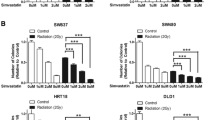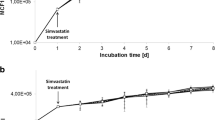Purpose:
To evaluate the effect of lovastatin alone or combined with radiation on U87MG and FaDu cells in vitro and U87MG tumors in vivo.
Material and Methods:
Cell number, p21WAF1 expression, apoptosis, reproductive cell death, and cell-cycle distribution were investigated after incubation of U87MG and FaDu cells in vitro. The effect of lovastatin (50 mg/kg/day) on tumor growth and on tumor growth delay after single-dose irradiation with 20 Gy was investigated using U87MG tumors in nude mice.
Results:
Lovastatin dose dependently decreased cell number and proliferation of U87MG and FaDu cells. The proportion of cells in G0/G1 phase, apoptosis and p21 protein expression increased after lovastatin alone or combined with 4-Gy irradiation in both cell lines. Effects of lovastatin on cell cycle and cell number were more pronounced in U87MG compared to FaDu. No radiosensitization of clonogenic cells by lovastatin could be demonstrated in both cells lines, but the colony-forming ability after lovastatin alone was decreased in FaDu cells. In vivo, lovastatin decreased tumor volume over time but did not increase growth delay after irradiation of U87MG tumors with 20 Gy.
Conclusion:
The data support effects of lovastatin on proliferation, apoptosis and colony-forming ability in vitro and tumor volume in vivo. At the drug concentration achievable, lovastatin did not improve the effects of radiation on U87MG tumors in vivo.
Ziel:
Der Effekt von Lovastatin allein und in Kombination mit Bestrahlung auf U87MG- und FaDu-Zellen in vitro und U87MG-Tumoren in vivo wurde untersucht.
Material und Methodik:
Zellzahl, p21WAF1-Expression, Apoptose, reproduktiver Zelltod und Zellzyklusverteilung wurden nach Inkubation von U87MG- and FaDu-Zellen in vitro evaluiert. Der Effekt von Lovastatin (50 mg/kg/Tag) auf Tumorwachstum und Tumorwachstumsverzögerung nach Einzeitbestrahlung mit 20 Gy wurden an U87MG-Tumoren in Nacktmäusen untersucht.
Ergebnisse:
Lovastatin reduzierte dosisabhängig die Zahl und Proliferation von U87MG- und FaDu-Zellen in vitro. Der Anteil von Zellen in G0/G1, der Anteil apoptischer Zellen und die p21WAF1-Expression stiegen in beiden Zelllinien nach Lovastatin allein oder in Kombination mit 4-Gy-Bestrahlung. Die Effekte von Lovastatin auf Zellzahl und Zellzyklus waren bei U87MG ausgeprägter als bei FaDu. Ein strahlensensibilisierender Effekt von Lovastatin bezüglich des klonogenen Zelltods wurde bei keiner der Zelllinien gefunden, Lovastatin allein reduzierte jedoch die Koloniebildungsfähigkeit von FaDu-Zellen. In vivo reduzierte Lovastatin das Volumen von U87MG-Tumoren, führte aber zu keiner Verlängerung der Tumorwachstumsverzögerung nach Einzeitbestrahlung mit 20 Gy.
Schlussfolgerung:
Lovastatin zeigt Effekte auf die Proliferation, Apoptose und Koloniebildungsfähigkeit in vitro und das Tumorvolumen in vivo. In der erreichten Dosierung führt Lovastatin nicht zu einer Verstärkung des Effekts einer Bestrahlung von U87MG-Tumoren in vivo.
Similar content being viewed by others
Author information
Authors and Affiliations
Corresponding author
Rights and permissions
About this article
Cite this article
Gabry's, D., Dörfler, A., Yaromina, A. et al. Effects of Lovastatin Alone or Combined with Irradiation on Tumor Cells in Vitro and in Vivo. Strahlenther Onkol 184, 48–53 (2008). https://doi.org/10.1007/s00066-008-1805-7
Received:
Accepted:
Issue Date:
DOI: https://doi.org/10.1007/s00066-008-1805-7
Key Words:
- Lovastatin
- Radiation
- Molecular targeting
- Radiation sensitization
- Apoptosis
- Cell-cycle distribution
- Cytotoxicity
- Tumor growth delay




